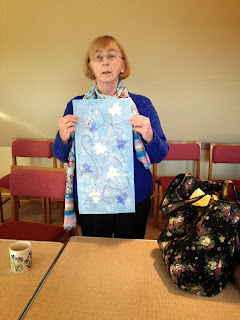Tuesday 25 June 2013
Our panel was not yet complete. We had passed the closing date by 2 days but we were thankful the Facebook group stated 'Don't rush the embroidery'.
In the morning the panel looked like this.
As you can see most of it has been completed. What a difference the outline makes.
What has been completed since the previous post is as follows.


Ella had the panel after Louise and she finished the croft and the fields behind the croft. She used a very close chain stitch which gave it the look of the lines of the fields behind her house. It frames the top of the panel lovely. She also added some lichen to the end of the stone wall.
She also completed the teachers blackboard which has the notes to Jesus Loves Me This I Know.


Dorothy added the Caithness Scorrie. A Scorrie is Caithness Dialect for a Seagull. She also added WK8 to the boats sail. WK is the Port Registration Number for the port of Wick. 8 is the number of stitchers this panel had.
Catherine finished the cliff with the Lighthouse. She added some French Knots and some straight lines for the sea. There are numerous lighthouses around Caithness and in the Pentland Firth which is one of the fastest tidal races in the world where the Atlantic meets the North Sea twice a day.
This is Catherine adding a 'Hairy Brotag'


A Hairy Brotag is a caterpiller for the Tiger Moth. They are most comical creatures and can be found on the peats waggling their hairy bodies.

This is the final Alexander Bain Clock with the writing outlined
Louise went to the Caithness Horizons Museum and found an electric motor that was made by Alexander Bain.

This is the final Morven panel. When the outline was added there was room for more stitching and Louise still wanted to dampen the blue of the flow country lochan.


This is the final Hen Harrier. Joan added some grasses and heather flowers.
This is the final Altnmarlich Cross. Celia added a couple of highlighting stitches and an outline to the lettering.

This was our party lunch. We had a feast worth of the hours spent stitching.

This is Dorothy adding up the hours and announcing how many we had entered into the book.
In the book there was over 570. It did not include the time spent researching, unpicking, trying out practice squares and the Tuesdays when we were all stitching at the same time.
We estimate it took us over 650 hours since January 8 2013.
On the days stitching the following was finally completed.
We had a visitor of Norma.
Her reaction was 'Wow, just Wow'.























































